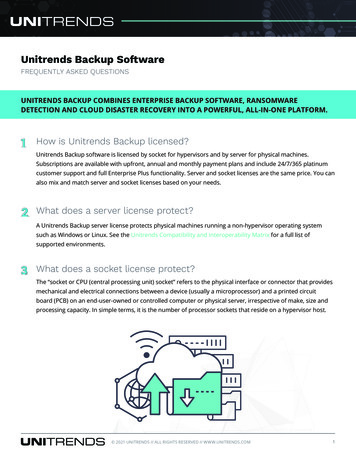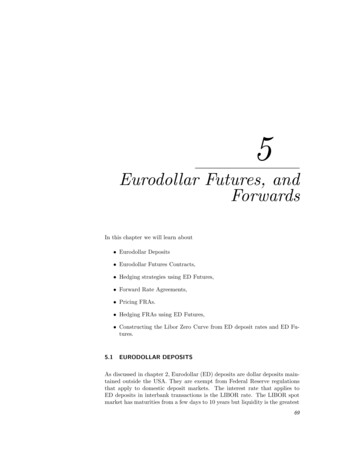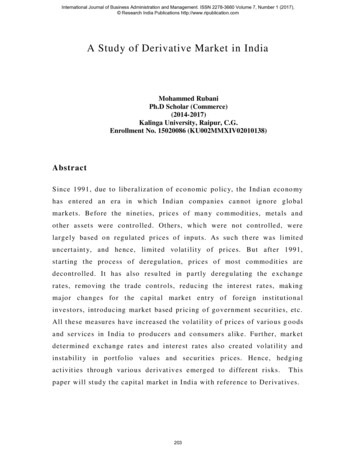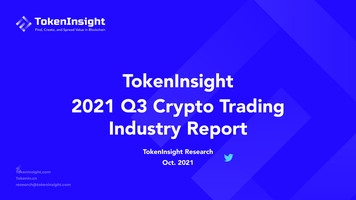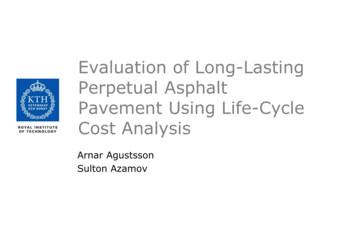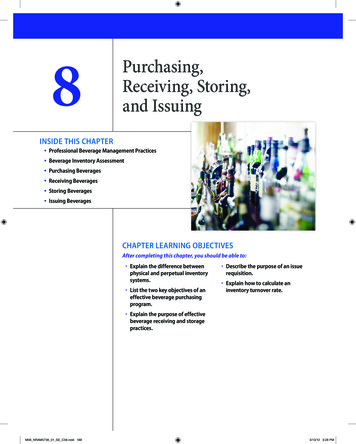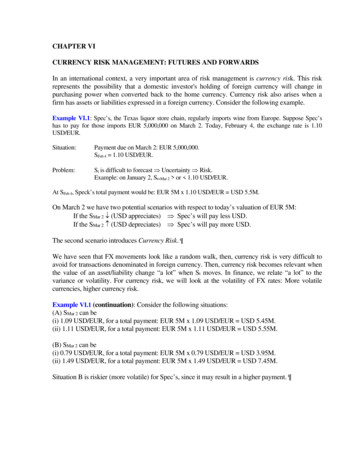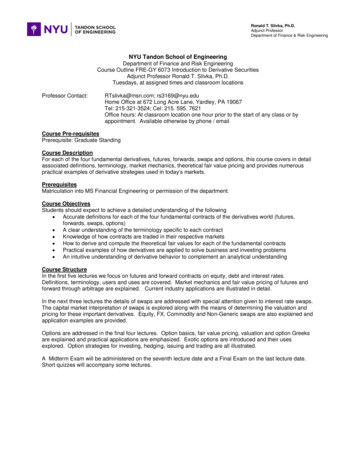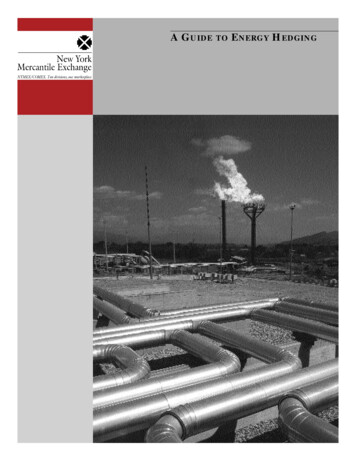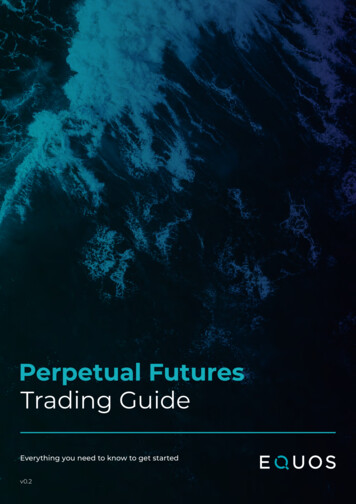
Transcription
Perpetual FuturesTrading GuideEverything you need to know to get startedv0.2
IntroductionThis handy guide will explain everything you need to know about EQUOSPerpetual futures, from the very basics for the newbies right up to theintricacies for the most advanced traders.Table of ContentsWhat are Perpetual Futures?3Why Trade Perpetuals?3Tell me the basics4The Technicals8Product Specifications8Exchange Index9Marking9Basis & Basis Payment Calculation12P&L14Leverage and Margin15Liquidation Process21Further Reading28
What are Perpetual Futures?Perpetual futures are futures contracts with no maturity, as opposed todated futures, which expire at a pre-set date and time such as every monthor every quarter. Any position in a perpetual future stays open until thetrader decides to close the trade by executing an offsetting trade, or untilthe trade gets liquidated by EQUOS. We will come back to this later.As perpetual futures have no set expiry they are, in a way, similar to spotexposure. To ensure that perpetual prices are kept in line with the spotmarket, the contracts have an exchange of payment between buyersand sellers depending on where the future price is trading relative to theunderlying spot price. At EQUOS, we refer to the spread between spot andperpetual futures prices as Basis. Other platforms may refer to this value asfunding, which is the equivalent practice.Why Trade Perpetual Futures?Margin: the advantage of trading a perpetual future over a spot contract isthat perpetuals offer the trader the ability to trade on margin - rather thanhaving to fund the full notional of the trade(the USDC value of the position), the trader has the option to put down only part of the notional in margin.Therefore, trading perpetuals is more capital efficient. We will explain moreabout margin in the next section.No need to own the underlying: a perpetual future is a derivative, whichmeans that the payoff of the contract is based on the underlying asset, suchas Bitcoin BTC, but there is no need to own the underlying itself. Any profitsand losses will be settled directly in USDC in your account.Ability to trade both directions: traders can buy (go long) or sell (goshort) perpetual futures, therefore they can benefit from prices going upas well as prices going down. This cannot be easily done when trading theunderlying directly.Risk management: traders can use perpetual futures to hedge positions.Perpetual Futures Trading Guide3
Tell me the basicsWhen trading or reading about perpetuals, you will see a lot of terminologythat is being used. We explain the most common terms here.P&LP&L stands for Profit & Loss, which can be both realized and unrealized.Unrealized P&L can be viewed as profits or losses on paper. Realized P&L arethe profits or losses reflected in your account. In traditional markets, P&L isunrealized when the price of an underlying asset changes after a trader hasopened a position, but before the trader has closed their position.On EQUOS, P&L for open perpetual futures positions is always unrealized - P&Lis only realized when the position is closed.Notional ValueThe notional value, often shortened to notional, is the total value of a position.For example, a position of 2 BTC Perpetual futures where one BTC Perpetualfuture is priced at 10,000 USDC will have a notional of 20,000 USDC.Leverage and MarginOn EQUOS traders have the option to partly fund the notional of their perpetual trades. In other words, a trader can have a notional exposure that is amultiple higher than the cash used to place the trade. This is referred to asleverage. Margin, also called collateral, is the amount that a trader has fundedtheir account to trade with.Perpetual Futures Trading Guide4
LeverageLeverage:the ratio betweenyour margin balanceand the notionalexposure of yourportfolio.Margin:the amount ofcapital used to funda trade.On EQUOS traders have the option to tradeperpetual futures with leverage. For cryptocurrencyfutures, leverage trading is actually more similarto margin trading. On EQUOS the derivativesproducts, such as our BTC Perpetual future, arenot leveraged. However, traders have the option tofund each dollar of notional exposure with a smalleramount of capital, called margin or collateral. Forexample, if you are using 5x leverage, your notionalexposure is 5x the amount you have put down asfunding. In other words, you are funding 1/5th ofyour trade with margin.On EQUOS, the amount of leverage available totrade depends on your position size - the larger theposition you have, the less amount of leverage youare allowed. Conversely, the smaller your position is,the larger the amount of leverage you are allowed.Initial MarginInitial Margin:the minimumamount of USDCrequired to openany new position.The amount of capital required to open any newposition is also referred to as the Initial Margin. Toopen a larger sized position requires a relativelylarger amount of Initial Margin than to open asmaller sized position.A trader may choose at any time to increase thebalance in their margin account to exceed theInitial Margin requirement. Increasing the marginbalance would reduce the trader’s leverage.Total Account MarginTotal AccountMargin:total USDCequivalentnotional of allassets availablefor margin,including anyunrealized P&L,less any capitalrequired for opennon-margin (spot)orders.Not all assets that are in your portfolio, maynecessarily be eligible to be used as margin.The USDC equivalent notional of all assets thatare eligible to be used for margin, including anyunrealized P&L and less any capital required fornon-margin (spot) trades, is your Total AccountMargin.As long as the Total Account Margin is higherthan the Initial Margin requirement, a trader isable to continue to send orders. As soon as theTotal Account Margin falls below the Initial Marginrequirement, the trader can no longer send ordersunless they reduce their notional position.Perpetual Futures Trading Guide5
LiquidationLiquidation:when a positionis forced to beclosed out becauseinsufficient marginremains in thetrader’s account tokeep the positionopen.Liquidation is when a position has to be unwoundbecause insufficient margin remains in theaccount.EQUOS has unique features and functionalityexplicitly dedicated to managing liquidationorders. When the position has been unwound,the trader is charged a liquidation fee. If there isany margin left in the account after liquidationand the payment of the liquidation fee, this will bereturned to the trader.Margin Liquidation TriggerMarginLiquidationTrigger:the minimumamount of USDCequivalent notionalrequired to avoidforced liquidation.If the Total AccountMargin fallsbelow the MarginLiquidation Trigger,the account’spositions will getliquidated.To avoid liquidation, your account needs to havea minimum amount of margin, this value is calledthe Margin Liquidation Trigger. When your TotalAccount Margin reaches the level of the MarginLiquidation Trigger, your account will start to getliquidated.Specifically, an account is flagged for liquidationwhen the Total Account Margin falls below theMargin Liquidation Trigger. At this point theliquidation engine takes over the position, and willtry to unwind the position at the best availableprice.Perpetual Futures Trading Guide6
Market Price, Mark Price and the ExchangeIndexOn EQUOS we differentiate between the Market Price and the Mark Priceof the perpetual. The Market Price is the last traded price of the product onEQUOS. There may be instances where the last traded price of the product isout of proportion compared to the market, for example in case of a particularlarge order or an illiquid order book, both of which may move the last tradedprice significantly up or down. The Mark Price therefore is used to indicatea fairer value for the contract, taking an average over a certain time periodto smooth out any temporary spikes in prices, preventing unnecessaryliquidations.The Exchange Index is a basket of spot contracts across a multiple ofexchanges, which is used as a reference price to ensure our Mark Price doesnot diverge too far from the rest of the market due to, for example, marketmanipulation or an illiquid order book.How the Market Price and Exchange Index are used to calculate the MarkPrice is explained in detail in The Technicals section.Basis and Basis PaymentAs we mentioned previously, perpetuals have a mechanism to ensure pricingaligns with the underlying spot product - see Market Price, Mark Price and theExchange Index. We refer to the spread between the Spot and the Perpetualcontract as Basis. The resulting exchange of payment between long and shortholders of the contract is called the Basis Payment.Perpetual Futures Trading Guide7
The TechnicalsIn this section, we describe the technical aspects of the EQUOS BTC Perpetualfutures in more detail. These product specifications are valid at the time ofwriting (September 2020) but may be changed at any time by EQUOS. Tomake sure you are up to date at any point, please refer to the EQUOS website.Product SpecificationEQUOS BTC Perpetual futureProduct SpecificationInstrument TypePerpetual futureTickerBTC/USDC[F]NameBTC/USDC [Perpetual Future]Underlying1 BTCSettlementCash settled in USDCMinimum Trade Size0.001 BTCTick Size0.01 USDCExpiryThe perpetual futures are non-expiring, which means that positions inthe contract are never “expired” or “matured”, however, there is a processevery 8 hours that applies.Market PriceLast traded price if the future is not paused3-second TWAP of the Market Price or, if not available, Exchange Index Basis at last Basis calculationMark PriceThe TWAP is based on the average of the open, high, low and close ofeach 1 second bar. The Mark Price will be capped at (Exchange Index 0.2%) and floored at (Exchange Index -0.2%)Max Leverage125xInitial MarginDepending on position size, starting from 0.8%Basis8 hour TWAP of (Spot Market Price - Future Market Price)The Basis is capped/floored at /- 0.375% x Mark PriceBasis PaymentPosition Size x BasisBasis Calculation WindowBased on an 8-hour TWAP periodBasis SettlementBasis settlements take place every day at 04:00, 12:00 and 20:00 UTCFeesFees are charged based on customer fee tierLiquidation Fee0.375%Position LimitThere is no maximum position limit for this product.Perpetual Futures Trading Guide8
Exchange IndexOn EQUOS the Exchange Index serves as a bound for the Perpetual MarkPrice, such that where EQUOS Perpetual prices diverge too far from theExchange Index, the Perpetual Mark Price is set to the Exchange Index /- aspread.The Exchange Index is the average of the last traded BTC Spot price overseveral exchanges. For the EQUOS BTC Perpetual contract the ExchangeIndex consists of the following exchanges, equally weighted and convertedinto USDC:ExchangeProduct (Spot)BinanceBTC/USDT or BTC/USDC, whichever was traded miniBTC/USDPrices are retrieved every 100ms. Any prices older than 100ms are removed. Ifno exchange provides a price in the last 100ms, the Exchange Index will keepthe previous price.MarkingOn EQUOS, we differentiate between the Market Price and the Mark Priceof the perpetual. The Market Price is the last traded price of the product onEQUOS.Market Price:the last tradedprice.The Market Price may deviate (significantly) from the rest of the market forexample in case of large orders or an illiquid order book. The Mark Price givesa fairer value for the contract by taking a 3-second TWAP of the Market Price.A TWAP is the average of the open, high, low and close price for a specificperiod. In the case of the Mark Price these periods are three 1-second intervals.As the Mark Price is used for P&L calculation and to determine whether theposition needs to be liquidated, using a TWAP to smooth out temporaryspikes in prices should prevent unnecessary liquidations.Perpetual Futures Trading Guide9
On many other platforms the Mark Price is based on an (Exchange) Index,which is a basket of spot contracts across a multiple of exchanges. On EQUOSthe perpetual futures Mark Price is based on the EQUOS Perpetual productitself as we believe this to be more prudent. However, our Mark Price will bebound by a spread to the Exchange Index to prevent market manipulation.The spread bound to the Exchange Set is initially set at 0.2% but as theliquidity on our platform grows we plan to relax this bound. Over timeperpetual futures on EQUOS thus becomes less reliant on the Exchange Indexand more a product of EQUOS’ own order book.The TWAP is based on the open, high, low, and close price of 1-second bars.PerpetualMark Price: the3-second TWAPof Market Pricebound to theExchange Index /- 0.2%. If theMarket Price isnot available,Exchange Index Basis at last basiscalculation.ExampleThe below examples show the relation between Market Price and the MarkPrice. We illustrate the effect of bounding the Mark Price to the ExchangeIndex by assuming the last executed trade was a particularly large order andtherefore got filled significantly lower than previous orders.Example 1 - The effect of a large order on theMarket PriceAssume we have had the following tradedprices for EQUOS BTC Perpetual over the past 3seconds, and the very last trade was a particularlylarge order that therefore got filled at a pricesignificantly below the rest of the orders and themarket.TimeTraded 415:03:069,953Perpetual Futures Trading Guide10
After trade 13 got executed, the Market Price of the EQUOS BTC Perpetualfuture was 9,997 USDC. The particularly large order, trade 14, got filled at9,953 and therefore pushes the Market Price down by 0.44% to 9,953 USDC.Example 2 - How the Mark Price differs from the Market PriceTo calculate the Mark Price, we need to calculate the TWAP. The TWAP isthe average of the Open, High, Low, and Close for each 1-second rk Price9,994.25Thus, the 3-second TWAP of the Market Price in this case is 9,994.25 USDC.Let’s further assume the Exchange Index is at 10,000 USDC. The bounds to ourMark Price then are 10,000 x (1 - 0.2%) 9,980 USDC and 10,000 x (1 0.2%) 10,020 USDC.As 9,994.25 is within the bound, we say the Mark Price 9,994.25 USDC.Note that the Market Price is 0.41% below the Mark Price. If we would havemarked the contract at the Market Price, this could have caused liquidationsof positions from highly leveraged traders.Example 3 - When the Mark Price hits the Exchange Index boundAssume the same traded prices as in the previous examples such that ourMarket Price is still 9,953 USDC and the 3-second TWAP of the Market Price isstill 9,994.25 USDC.Now assume that the Exchange Index is trading at 10,020 USDC. The boundsto the Mark Price now are 10,020 * (1 - 0.2%) 9,999.96 USDC and 10,020 * (1 0.2%) 10,040.04.In this case the 3 second TWAP of the Market Price is outside of the boundsto the Exchange Index. The Mark Price is set to the nearest bound, such thatMark Price 9,999.96 USDC.Perpetual Futures Trading Guide11
Basis & Basis Payment CalculationBasisAt EQUOS, the Basis is calculated and settled in USDC every 8 hours at 04:00,12:00, and 20:00 UTC.In order to calculate the Basis of the perpetual future, we compare thedifference between the Market Price of the EQUOS Spot contract and theMarket Price of the EQUOS Perpetual contract over the past 8 hours:Basis 8 hour TWAP of (Spot Market Price - Perpetual Market Price)The TWAP is based on the average of the open, high, low and close of each 1minute bar.The Basis is capped/floored at /- 0.375% * Perpetual Mark Price at the Basiscalculation time to avoid instantaneous liquidation for positions with highleverage.Note that the Market Price may be different from the Mark Price used to valuefutures contracts during trading hours, which is bound by the Exchange Indexto protect market participants against manipulative trading.Basis PaymentThe Basis Payment is an exchange of payment between long and shortholders of the perpetual contract, based on the calculated Basis:Basis Payment Position Size * BasisThe Basis and Basis Payment are defined from a long holders perspectivesuch that when Spot Market Price Perpetual Market Price, every long holderof the contract pays the short holders of the contract a value equal to theirPosition Size x Basis.The Basis Payment is only paid or received if a position in the contract is heldat the time of Basis calculation.Perpetual Futures Trading Guide12
ExamplesExample 1 - When the perpetual future trades above the spotTrader A, let’s call him Matt, has bought 2 EQUOS BTC Perpetuals and is thuslong. We say Matt’s position size is 2. Trader B, let’s call her Julie, has sold 2EQUOS BTC Perpetuals and is thus short. We say Julie’s position size is -2.Let’s assume that over the past 8 hours, the EQUOS BTC Perpetual MarketPrice was continuously 20 USDC higher than the EQUOS BTC Spot MarketPrice. The Basis is -20 USDC. Furthermore, assume that at the time of thebasis calculation the EQUOS Spot Market Price is 10,000 USDC, the EQUOSPerpetual Market Price is 10,020 USDC, and the EQUOS Perpetual Mark Priceis 10,015 USDC.Basisfloor -0.375% * Perpetual Mark Price -0.375% x 10,015 USDC -37.56 USDCThe Basis is negative and does not exceed the floor, therefore Matt pays 2 * -20USDC -40 USDC, whereas Julie receives -2 * -20 40 USDCExample 2 - When the perpetual future trades below the spotAssuming Matt and Julie’s positions from the first example, such that Matt’sposition size is 2 and Julie’s position size is -2.Assume that over the past 8 hours, the EQUOS Perpetual Market Price wascontinuously 50 USDC lower than the EQUOS Spot Market Prices. The Basis is 50 USDC. Furthermore, assume that at the time of the basis calculation theEQUOS Spot Market Price is 10,000 USDC, the EQUOS Perpetual Market Priceis 9,950 USDC, and the EQUOS Perpetual Mark Price is 9,955 USDC.Basiscap 0.375% * Perpetual Mark Price 0.375% x 9,955 USDC 37.33 USDCThe Basis is positive and exceeds the cap. In this case Trader A receives 2* 37.33 USDC 74.66 USDC, whereas Trader B pays -2 * 37.33 USDC -74.66USDCPerpetual Futures Trading Guide13
P&LEQUOS Perpetual futures are USDC denominated, therefore any P&L is settledin USDC. P&L on open EQUOS Perpetual future positions is always unrealized.Unrealized P&L is updated continuously based on the latest Mark Price:Unrealized P&L Position Size x (Mark Price - Entry Price)Unrealized P&L cannot be withdrawn from the platform. To realize andwithdraw P&L, a trader can close and re-enter the trade. Realized P&L on theposition is based on the difference between the entry and the exit price.Realized P&L Position Size x (Exit Price - Entry Price)ExamplesIn a real life example, let’s call our trader Andy. Andy enters into a long position of1.5 EQUOS BTC Perpetual at 10,000. Assume the Mark Price is at 10,005 USDCAndy’s Unrealized P&L Position Size x (Mark Price - Entry Price) 1.5 * (10,005 USDC - 10,000 USDC) 7.50 USDCAt the next Basis cycle, assume the Basis is 10USDC, and the Mark Price has reduced to 9,975USDC.At some point before the next Basis calculation,Andy decides to unwind his full position by selling1.5 EQUOS BTC Perpetual and is able to do so at9,950 USDC.Andy’s Total P&L balances, including trade P&L andfunding, areAt the next Basis calculation, the Basis is -15 USDC.The Mark Price of the EQUOS BTC Perpetual hasdropped further to 9,800 USDC. As Andy doesnot hold any positions anymore, his P&L balancesremain unchanged:Andy’s P&L balances arePositionUnrealized P&LRealized P&L1.5 BTC7.50 USDC0 USDCAndy’s P&L balances now arePositionUnrealized P&LRealized P&L1.5 BTC-37.50 USDC 15 USDCAndy’s Unrealized P&L on the trade Position Size x (Exit Price - Entry Price) 1.5 x (9,950 USDC - 10,000 USDC) -75 USDCPositionUnrealized P&LRealized P&L0 BTC0 USDC-60 USDCPositionUnrealized P&LRealized P&L0 BTC0 USDC-60 USDCPerpetual Futures Trading Guide14
Leverage and MarginMaximum leverage, margin requirements, and assets eligible for margin asdiscussed in this section may be updated from time to time. To ensure you areup to date, please find a link to the latest information in section 5.Eligible CollateralCurrently, EQUOS accounts can only be funded with USD and USDC inorder to be used as margin for trading perpetual futures. The Total AccountMargin expresses the total of assets available for margin in USDC equivalent,including any unrealized P&L and minus any capital for open spot orders. OnEQUOS, any USD is converted into USDC on a 1-for-1 basis.Leverage limits and Initial MarginEQUOS offers a maximum of 125x leverage but the overall leverage allowedfor a position depends on the size of that position. This is set out in the tablebelow. The limits on position sizes for given leverage levels are designedsuch that they align the expected risk on the platform with regard to tradingvolume to the size of the Liquidation Reserve. This is to limit the probability ofauto-deleveraging (ADL). These limits will be reviewed regularly and amendedas necessary.LeverageMax notional exposure (USDC)Initial MarginMargin Liquidation %1.525,000,00066.67%33.33%Any notional over USDC 25,000,000 requires 100% Initial Margin.Perpetual Futures Trading Guide15
The Initial Margin required for a certain size position is directly related to themaximum leverage available for that position size. On EQUOS, the InitialMargin requirement follows a tax style bracket approach, starting from thehighest leverage bucket. This means that a trader who wants to open aBTC Perpetual position with a 25,000 USDC notional has to pay 0.80% InitialMargin on the first 10,000 USDC and 1% on the remaining 15,000 USDC.The leverage on any account is the ratio between the margin balance and thenotional exposure of that account. Explicitly:Account Leverage Position Notional / Total Account MarginThis may be different from the maximum leverage that is allowed at theinception of the trade as inferred from the above table, which is a function ofthe notional exposure and the Initial Margin required:Maximum Leverage Position Notional / Initial MarginA trader’s Total Account Margin thus needs to be at least equal to the InitialMargin for them to be able to execute the trade. However, a trader can at anypoint reduce their leverage by ensuring their Total Account Margin exceedsthe Initial Margin.On EQUOS, margin is also required for open orders (orders that have beensent to the order book, but that have not yet been filled). The margin on openorders is included in the account’s Initial Margin, but also shown separately asReserved Margin.Perpetual Futures Trading Guide16
Margin Liquidation TriggerThe Margin Liquidation Trigger is always 50% of the Initial Margin required foropen position(s) only. The Margin Liquidation Trigger thus does not take intoaccount any open order(s), and it is independent of the Total Account Marginin the account at the time when the trade was executed.ExamplesFor simplicity let’s assume the EQUOS BTC Spot and EQUOS BTC Perpetualfutures are both trading and being marked at 10,000 USDC throughout allbelow examples.Example 1a - What is Total Account Margin?Trader A, let’s call her Maria, has the following asset in her EQUOS wallet: 5 Bitcoin, currently marked at 10,000 USDC 1,500 USDC 1,000 USDAt EQUOS, USD is always converted into USDC at a 1-for-1 ratio. The value ofMaria’s assets equals 5 x 10,000 USDC 1,500 USDC 1 USDC x 1,000 52,500USDCAs BTC cannot currently be used as margin the assets available for margin,the Total Account Margin, is 2,500 USDC only.Maria’s account does not currently have any leverage.Perpetual Futures Trading Guide17
Example 1b - How to calculate Margin and LeverageAssume Maria wants to buy 100,000 USDC worth of EQUOS BTC Perpetualfutures. To do so, the Initial Margin requirement would be:10,000 x 0.8% 8015,000 x 1.0% 15025,000 x 1.33% 332.5050,000 x 2.0% 1,000Initial Margin 1,562.50 USDCThe maximum leverage allowed on this trade is thus:Maximum Leverage Position Notional / Initial Margin 100,000 / 1,562.50 64xAs Maria’s Total Account Margin is 2,500 USDC, which is higher than the InitialMargin, she is able to send the order. She will send an order to buy 10 BTCPerpetuals at 10,000 USDC, which gets filled straight away. Now that Mariahas a position, we can calculate the overall leverage of the account as follows:Account Leverage Position Notional / Total Account Margin 100,000 / 2,500 40xThe Leverage, Position and Margin balances for the Perpetual are: Leverage: 40x Position Size: 10 BTC Position Notional: 100,000 USDC Total Account Margin: 2,500 USDC Initial Margin: 1,562.50 USDC Reserved Margin: 0 USDC Margin Liquidation Trigger: 781.25 USDCPerpetual Futures Trading Guide18
Example 1c - The effect of sending an order on Initial MarginIn addition to her existing position, Maria sends a limit order to buy another5 BTC Perpetuals with a limit price of 9,000 USDC. This means that the orderwill only get executed at a price of 9,000 USDC or better which, in the case of abuy order, is lower.Buying 5 BTC Perpetual futures at 9,000 USDC yields a notional position of5 x 9,000 USDC 45,000 USDC. This exposure will be added to the existing100,000 USDC position to calculate the Initial Margin requirement on the totalposition.The additional notional exposure sits in the 2% margin bucket (which has atotal notional of 150,000 USDC), and the additional Initial Margin requirementas a result of the new order is 45,000 USDC x 2% 900 USDC. The overall InitialMargin requirement, including the new order, is 2,462.50 USDC.As Maria has 2,500 USDC Total Account Margin, she can send the order. Thelimit order will not be filled straight away, since the current price of 10,000USDC is above the limit price of 9,000 USDC. Therefore, the order stays openand the margin requirement on the order is shown under Reserved Margin.The Margin Liquidation Trigger remains unchanged, as do the leverage, position size, position notional, and total account margin: Leverage: 40x Position Size: 10 BTC Position Notional: 100,000 USDC Total Account Margin: 2,500 USDC Initial Margin: 2,462.50 USDC Reserved Margin: 900 USDC Margin Liquidation Trigger: 781.25 USDCPerpetual Futures Trading Guide19
Example 2 - Total Account Margin with an open Spot order to buy BTCAnother trader, let’s call him Dan has the following balances and positions: 20,000 USDC 10,000 USD 5 Bitcoin 1 BTC Perpetual marked at 10,000 USDC Unrealized P&L of -500 USDC 1 open spot order to buy 2 BTC at a price of 9,000 USDCThe USDC equivalent notional of all assets available for margin 20,000 USDC 1 USDC x 10,000 30,000 USDC.The capital required for open spot orders 2 x 9,000 USDC 18,000 USDC.Dan’s Total Account Margin, which is the USDC equivalent of all assets available for margin plus any unrealized P&L and minus any capital required foropen spot orders, thus is:Total Account Margin 30,000 - 500 - 18,000 11,500 USDCExample 3 - Total Account Margin with an open Spot order to sell BTCIn another example, let’s call our trader Jack, he has the following balancesand positions: 20,000 USDC 10,000 USD 5 Bitcoin 1 BTC Perpetual marked at 10,000 USDC Unrealized P&L of -500 USDC 1 open spot order to sell 2 BTC at a price of 9,000 USDCThe USDC equivalent notional of all assets available for margin 20,000 USDC 1 USDC x 10,000 30,000 USDC.The capital required for open spot orders in this case is zero as there is no benefit for selling USDC proceeds from selling BTC, until the trade has executed.Hence:Jack’s Total Account Margin 30,000 - 500 - 0 29,500 USDCCheck out our latest articles Leverage, Margin, and Liquidation, which is linkedin the next section.Perpetual Futures Trading Guide20
Liquidation ProcessWhen is an account liquidated?As we explained in the previous sections in this guide, an account is onlyable to send new orders as long as its Total Account Margin is higher thanthe Initial Margin required for all open positions and open orders. As soonas the Total Account Margin drops below the Initial Margin, the account canno longer send any new orders unless such order would reduce the existingposition (e.g. a sell order, when the current position is long). To continueadding positions (e.g. add buy orders, when the current position is long), thetrader will have to transfer additional funds that can be used for margin totheir wallet, close open orders, or close open positions.The Total Account Margin includes any (un)realized P&L and thus, if themarket moves against the position such that the P&L on the position isnegative, the Total Account Margin will reduce. When the Total AccountMargin falls below the Margin Liquidation Trigger, the account will start toget liquidated. This means that EQUOS will take over your positions and tryto unwind them by either attempting to sell, if the position to be liquidated islong, or attempting to buy, if the position to be liquidated is short.Perpetual Futures Trading Guide21
ExamplesTrader A, let’s call her Clare, has 10 BTC Perpetuals marked at 10,000 USDC,such that her Notional Position is 100,000 USDC. We know, from the previousexample, that the Initial Margin requirement for a 100,000 USDC position is1,562.50 USDC.Assume Clare has 1,750 USDC deposited in her wallet. She has not made anyP&
insufficient margin remains in the trader's account to keep the position open. Margin Liquidation Trigger: the minimum amount of USDC equivalent notional required to avoid forced liquidation. If the Total Account Margin falls below the Margin Liquidation Trigger, the account's positions will get liquidated. Perpetual Futures Trading Guide 6
